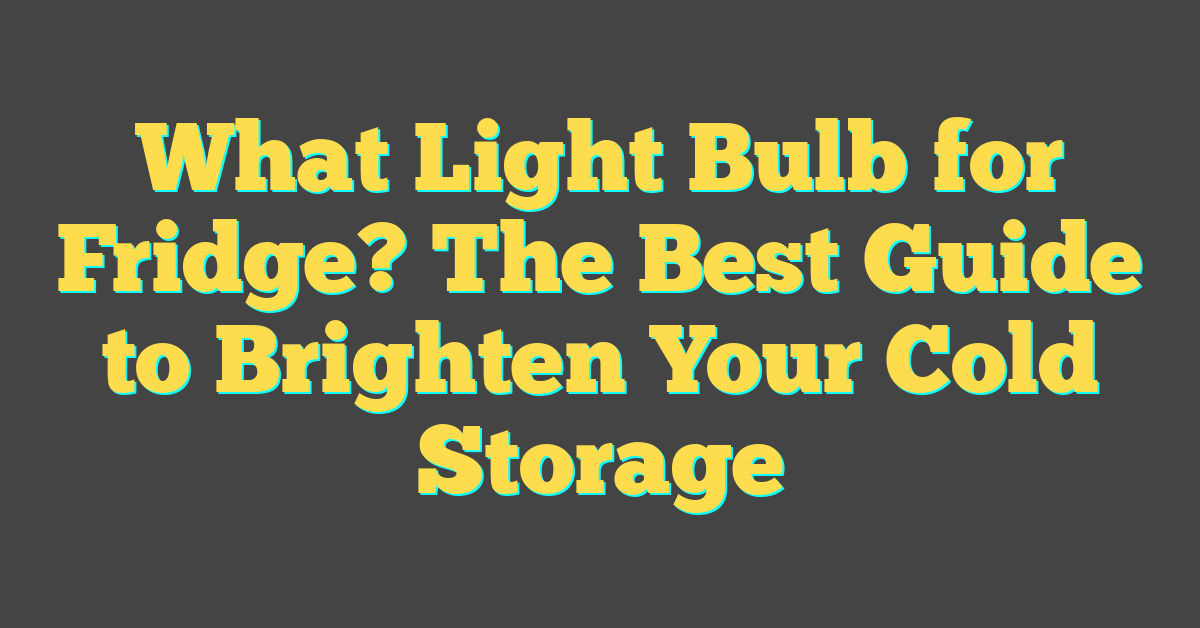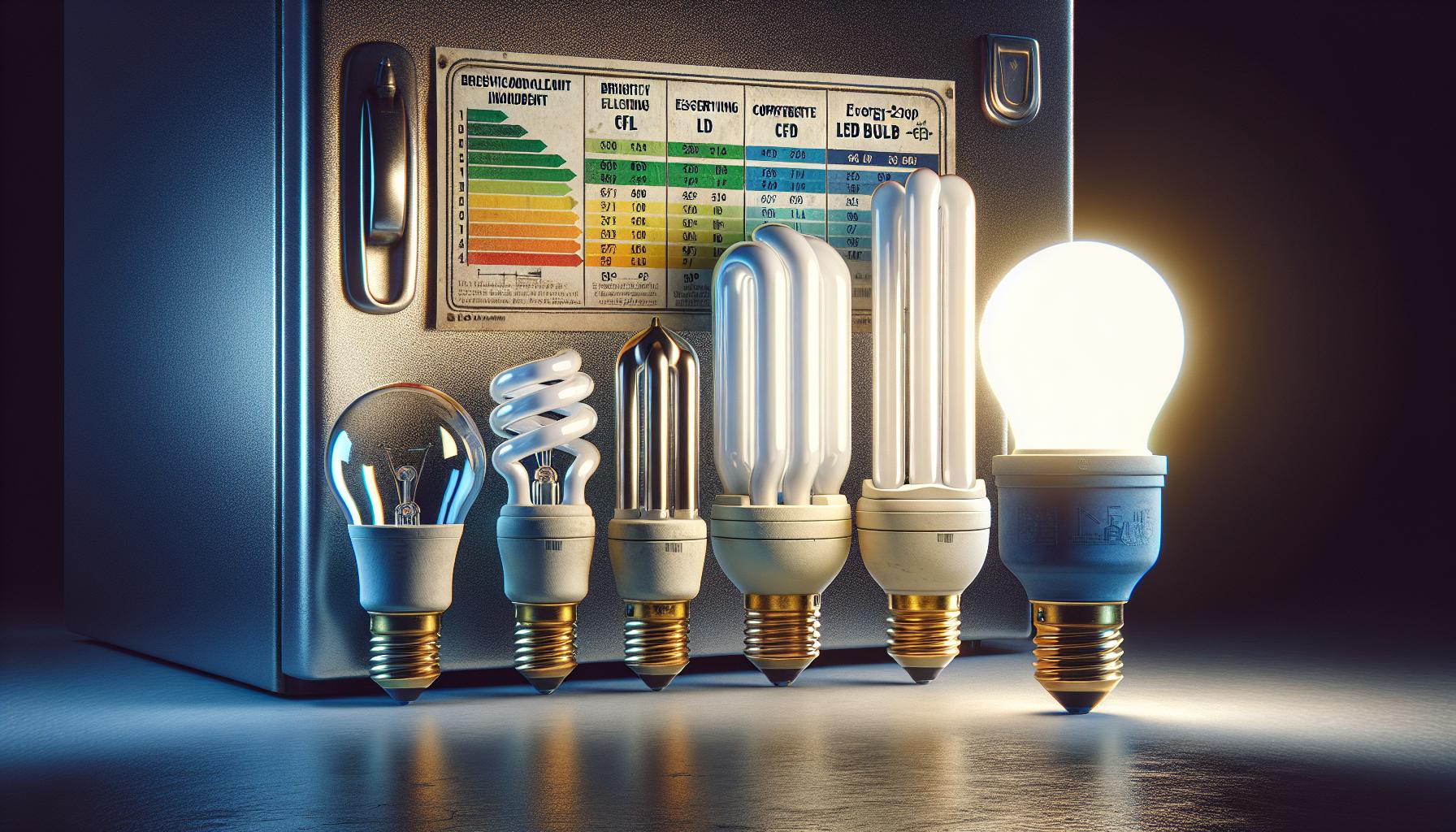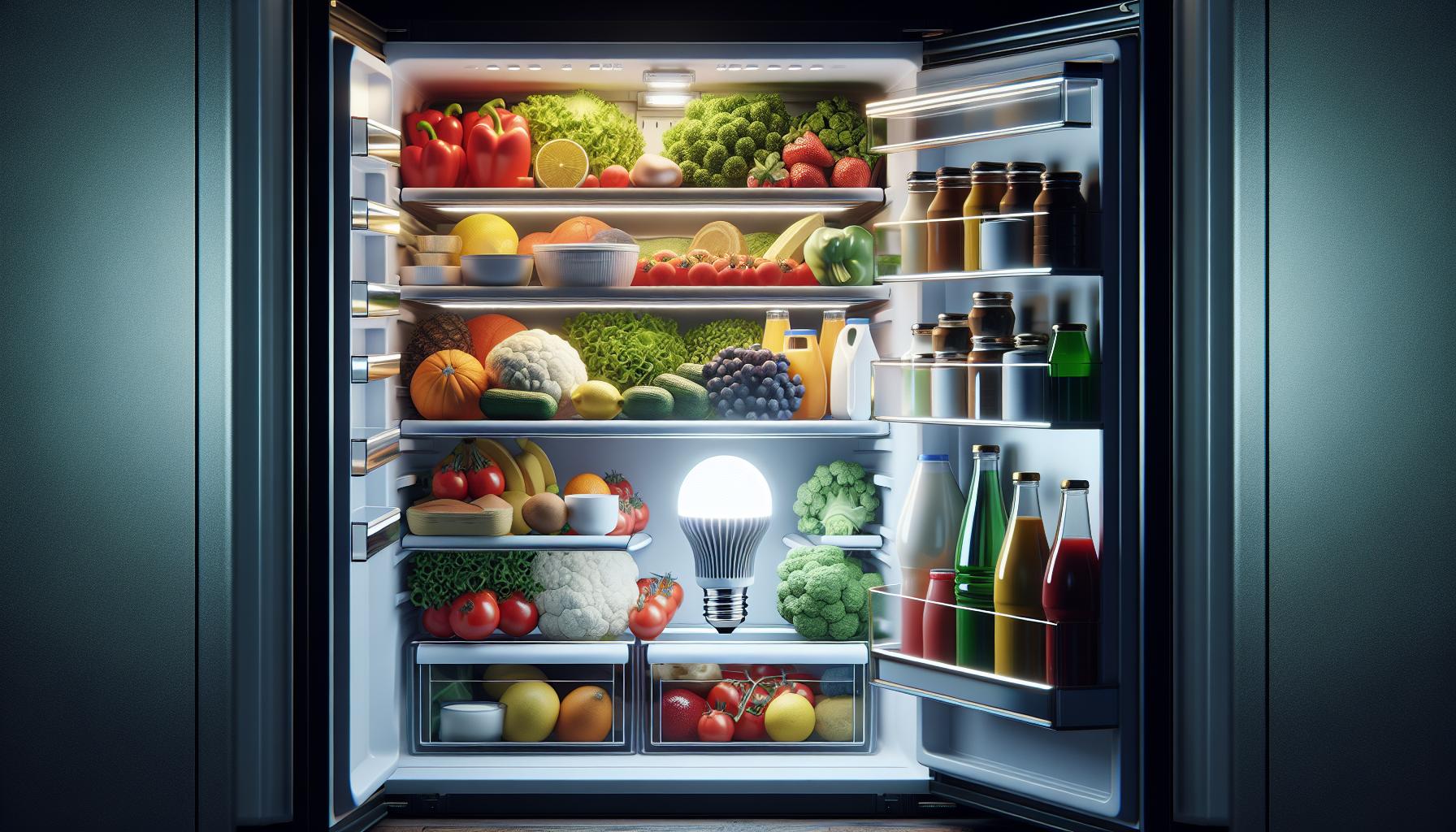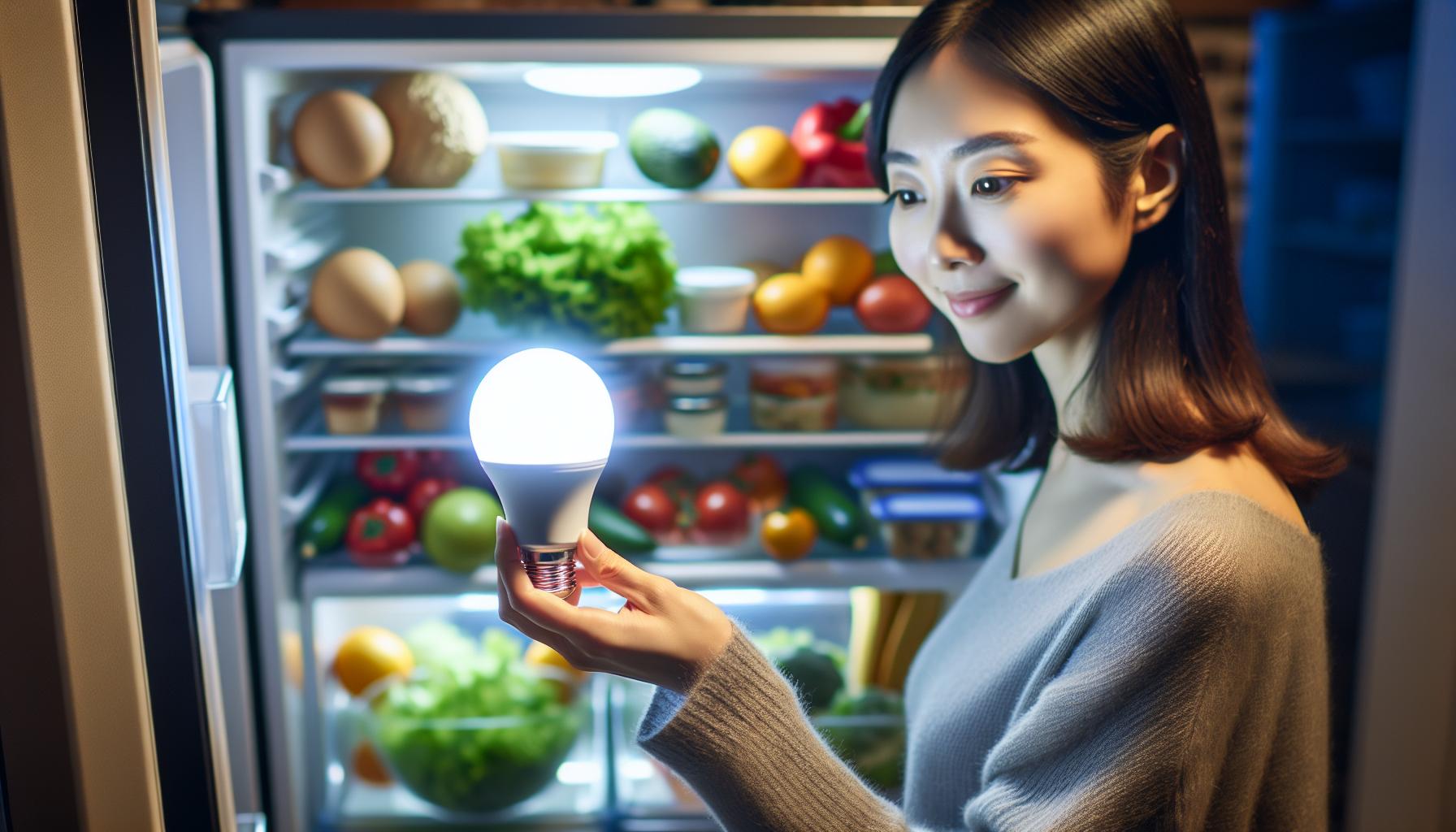Ever found yourself squinting into the fridge, trying to decipher if that’s cheddar or Swiss because the light’s gone out? You’re not alone! Choosing the right light bulb for your fridge is more important than you might think. It’s not just about seeing your snacks clearly; it’s about finding a bulb that’s durable, energy-efficient, and the right fit for your fridge.

You’ve got options, from LEDs to halogens, and each has its pros and cons. But don’t worry, you won’t have to navigate this alone. We’ll guide you through the maze of wattages, shapes, and sizes to find the perfect bulb that’ll make your midnight snack raids a brilliantly lit success.
The importance of choosing the right light bulb for your fridge
You might not think much of it, but the light bulb inside your refrigerator plays a crucial role in your everyday kitchen experience. While it’s easy to take this little light for granted, selecting the appropriate bulb can make a world of difference. Imagine groping around in the dim light, struggling to tell your cheddar from your gouda – not exactly the highlight of your day, right?
First off, durability is key. Your fridge light turns on and off multiple times a day, and you need a bulb that’s up to the task. Traditional bulbs that can’t handle frequent temperature changes will burn out faster, and believe it or not, it’s pretty annoying to replace them more often than necessary. On the other hand, LED bulbs last longer, which means they’re not only more convenient but also better for your wallet in the long run.
Energy efficiency is another biggie. Refrigerators are already one of the most power-hungry appliances in your home, so it makes sense to cut costs where you can. LEDs use up to 80% less energy than traditional incandescent bulbs, which translates to savings on your electricity bill and a greener world, thanks to lower carbon emissions. Who knew that something as small as a bulb could help the environment?
Lastly, the right fit is crucial. It’s not just about the bulb physically fitting in the socket – it’s about the quality of light as well. You want to avoid bulbs that are too dim or too harsh. Your goal is to find that sweet spot where you can see everything clearly without being blinded every time you reach for a midnight snack. As a DIY enthusiast and lighting connoisseur, you’re fully aware that the ambiance created by proper lighting cannot be overlooked, even in a space as utilitarian as the inside of a fridge.
Armed with this info, you’re well on your way to making an informed decision. Remember, the right choice can enhance convenience, save energy, and transform your late-night kitchen raids into something a little bit magical. Now, let’s dive deeper into the specifics of different bulb types.
Understanding the different types of light bulbs for fridges

When you’re on the hunt for the perfect fridge light bulb, you’ll encounter a few different types. It’s like picking the right tool for a DIY project—you need to know your options.
Incandescent bulbs have been the go-to for years, and you might still find them kicking around. They’re the old school pick, with a warm glow that’s familiar but they’re not so hot on energy efficiency. That said, if you’re a fan of that vintage vibe, they might be just what you’re after.
Moving on, you’ve got halogen bulbs. Think of these as the incandescent bulb’s cousin. A bit more efficient, a tad brighter, and they crank the heat up a notch, which isn’t always what you want in a fridge.
Compact Fluorescent Lamps (CFLs) represent the middle ground. More energy-efficient than incandescents and halogens, they’ll save you some energy, but they can be slow to light up and contain mercury, so you’ve got to handle them with care.
Then there’s the LEDs—the crème de la crème of modern lighting. Not only do they use up to 90% less energy, but they also last for ages. You install one of these in your fridge, and you’re set for years. Plus, they’re tough cookies, handling temperature changes like a champ. And with the development of LED technology, you’ve got a spectrum of color temperatures to choose from, so you can get just the right kind of light for your midnight snacking—without the harsh glare.
| Type | Energy Efficiency | Lifespan | Notes |
|---|---|---|---|
| Incandescent | Low | Short | Warm glow, traditional look |
| Halogen | Moderate | Moderate | Brighter, warmer temperature |
| CFL | High | Long | Contains mercury, slow start |
| LED | Very High | Very Long | Durable, wide range of colors, instant illumination |
Pros and cons of LED light bulbs for fridges

When you’re looking to upgrade your fridge’s lighting, you’ll find that LED bulbs are often at the forefront of recommendations. There’s a good reason for this. LED bulbs are the epitome of efficiency in today’s market. They consume significantly less power than traditional incandescents, which is a plus for both your energy bills and your eco-conscious mindset.
« What Kind of Light Bulbs Are Best for Your Eyes? Discover the LED Advantage
What Type of Light Bulbs for Dining Room: Illuminate with Style & Efficiency »
But efficiency isn’t the only advantage you’ll get from LEDs. These bulbs shine bright immediately, so there’s no waiting around for full illumination when you’re searching for a midnight snack. Plus, their longevity is unmatched—some LEDs can last up to 20,000 hours, which means you might forget the last time you changed the bulb in your fridge. For those who love the idea of a set-it-and-forget-it solution for their home DIY projects, LED bulbs deliver in spades.
Color temperature is another perk. Whether you prefer a cooler, daylight tone that helps you spot your food items with ease, or a warmer, softer light that makes your midnight raids feel less intrusive, LEDs have got you covered with a spectrum of choices.
Despite the heavy praise, LED bulbs do have a couple of limitations to consider. For one, the upfront cost is higher than traditional bulbs. While you’ll recoup those costs in energy savings, it’s something to bear in mind if you’re on a tight budget. Additionally, not all LED bulbs are created equal. Variability in quality is something you’ll encounter, so it’s essential to go for reputable brands to ensure consistent performance and avoid the annoyance of early failures.
To make your decision easier, let’s break down the pros and cons of LED bulbs in a simple format:
Pros
- Energy-efficient
- Long lifespan
- Instantaneous brightness
- Wide variety of color temperatures
- Higher initial cost
- Quality can vary between brands
LED bulbs have set a new standard in fridge lighting. With their blend of longevity, efficiency, and customizable ambiance, they can be an ideal component of your modern kitchen. Just remember to weigh the initial investment against the long-term benefits and shop for quality to ensure you’re getting the best bang for your buck.
Pros and cons of halogen light bulbs for fridges

If you’re delving into the details of halogen light bulbs for your fridge, you’ll find there are both bright spots and dimmer aspects to consider. These small, yet powerful bulbs are often overlooked, but they have characteristics that could make them a practical choice for your appliance.
Halogen bulbs, akin to your trusty old incandescents, bring a Warm Glow to Your Fridge’s Interior. They are known for providing a clear, natural light that can make your fruits and veggies look appetizing. But they’re not just about looks; halogen lights Heat Up Quite Quickly, delivering full brightness without delay, which is handy when you’re hunting for a midnight snack.
These bulbs also boast a Compact Size, making them suitable for even the snuggest nooks in your fridge. And let’s not forget their Dimmable Feature, allowing you to adjust the intensity of the light to your liking—a subtle perk not every fridge bulb can offer.
However, it’s not all sunshine and rainbows with halogen bulbs. Their energy efficiency is lower than LEDs, meaning they’ll nudge your energy bills upward. They might not lighten your wallet immediately, like LEDs do, but over time, halogens will prove to be the less economical choice. Moreover, these bulbs have a Shorter Lifespan, usually topping out around 2,000 hours. This means you’ll be replacing them more often compared to the marathon run of LED bulbs.
Then there’s the issue of Heat Production. Despite their inviting glow, halogens can get quite hot. This heat is generally not a safety concern for your fridge, but it can make for a slightly warmer interior.
For those who take on home DIY projects with glee, swapping a fridge bulb isn’t a herculean task, but with halogens, you’ll be doing it more frequently. And because the light quality can vary, you might have to try a few brands before finding your perfect match.
Ultimately, halogens present a solid, albeit less contemporary option for fridge lighting that may align with your preferences––just be ready to embrace the trade-offs.
Factors to consider when choosing a light bulb for your fridge

When you’re in the market for a new fridge light bulb, the sheer array of options might feel overwhelming. But don’t worry, as a seasoned DIY enthusiast and lighting aficionado, I’ll walk you through the key factors you need to consider.
Bulb Type
First and foremost, know your bulb type. You’re probably debating between LEDs and halogens as mentioned earlier. LED bulbs are top of the charts for energy efficiency and longevity, making them a go-to choice for many. Halogens, on the other hand, are praised for their crisp, natural light.
Size and Fit
Check your fridge’s manual for the specific bulb size required. Incorrect fit could lead to loose connections or a non-functioning light. Make sure the bulb you pick snugly fits into the socket.
Lumens, Not Watts
Gone are the days when wattage was the way to gauge light brightness. Today, it’s all about lumens. Look for a bulb with the right lumen count to provide sufficient brightness without being too harsh on your midnight snack runs.
- For reference, a range between 60 to 100 lumens is usually sufficient for a fridge.
Temperature Durability
Did you know that bulbs can be sensitive to temperature? You need one that stands up to the cold inside a fridge. LEDs are particularly robust in this regard, effectively functioning in a wide range of temperatures.
Ease of Replacement
While you don’t want to be replacing your bulb often, it’s a good idea to pick one that’s user-friendly when the time comes for a swap. Think twist and lock versus screws, or perhaps something you can handle without tools.
Remember, the right light bulb will merge seamlessly with your fridge’s mechanics, shining reliably without a frequent need for replacement. Energy consumption, lifespan, and operational robustness—they all play a pivotal role in your choice. Keep these tips in hand and light up your fridge with confidence.
Conclusion
Now you’re equipped with the knowledge to pick the perfect light bulb for your fridge. Remember, it’s not just about the brightness but also finding a bulb that can handle the chill and last a long time. Whether you lean towards the energy-saving LED or the natural glow of a halogen, make sure it fits snugly in your fridge. Here’s to a well-lit fridge that makes finding your favorite snacks a breeze!
Frequently Asked Questions
What type of bulb is best for a fridge?
For optimal energy efficiency and longevity, LED bulbs are the best choice for fridges. They are designed to withstand cold temperatures and have a longer lifespan compared to other bulbs.
What should I consider when choosing a fridge light bulb?
When selecting a fridge light bulb, consider the bulb type, size and fit, lumens for brightness, temperature durability, and the ease of replacement to ensure proper functioning within the fridge’s environment.
Is brightness important when choosing a fridge bulb?
Yes, brightness is important. You should look at the lumens rating to determine the light output instead of wattage. The right lumens will provide adequate brightness without being too harsh.
Can I use a halogen bulb in my fridge?
While halogen bulbs provide crisp, natural light, they may not be as energy-efficient or durable in colder environments compared to LED bulbs. Choose a bulb that will perform well in the low temperatures of a fridge.
How do I ensure the bulb fits my fridge?
Check your fridge’s manual for the recommended bulb size and fit. Bulbs come in various shapes and sizes, and it’s crucial to select a bulb that fits seamlessly with the fridge’s mechanics.




